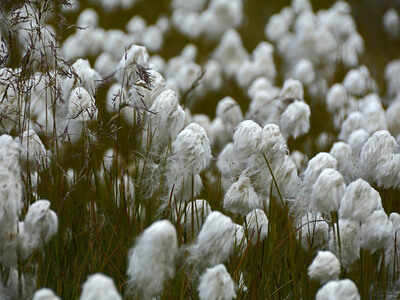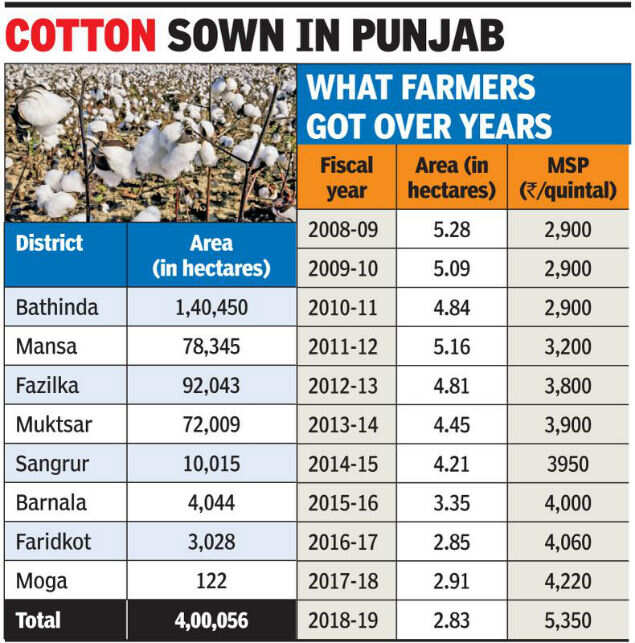
BATHINDA: In a reversal of sorts, the area under cotton cultivation has crossed four lakh hectares in Punjab for the first time in five years. The last time cotton was sown on more than 4 lakh hectares was in the 2014-15 season.
Primarily, the rise in area under the cash crop is seen as a reflection of its price crossing the Rs 6,000-per-quintal mark at the end of the 2018-19 season.

Though cotton is, ideally, sown till May 15 in Punjab, delayed harvesting of wheat due to untimely rain pushed sowing back to May 31. It was also being sown till Sunday. Any crop which is sown late is prone to pest attacks.
According to Punjab agriculture and farmer welfare department, cotton had been sown on 4,00,056 hectares in Punjab till Monday — a40% rise from the 2018-19 season, when the crop’s cultivation area was 2.83 lakh hectares.
The last time cotton was sown on more than 4 lakh hectares was in the 2014-15 season. At the time, the crop covered 4.21 lakh hectares. In 2015-16, area under it fell to 3.35 lakh hectares.
That season, over 60% crop was damaged due to a whitefly attack. For the next three years, the crop was sown on less than 3 lakh hectares of land — 2.85 lakh hectares in 2016-17, 2.91 lakh hectares in 2017-18 and 2.83 lakh hectares in 2018-19.
For this season, the agriculture department had initially a target of 3.2 lakh hectares for area under cotton, but later had revised it to 4 lakh hectares.
The department was not expected to meet the target at first, said an agriculture department official.
More farmers returning to cultivating cotton is seen as a positive trend because paddy consumes more water, which is in scarcity in Malwa.
Paddy transplantation is yet to start officially. Last year it was transplanted in nearly 390 lakh hectares. The minimum support price (MSP) for cotton was increased from Rs 4,220 per quintal in the 2017-18 season to Rs 5,350 per quintal in 2018-19.
“Going by the spurt in cotton prices in the end of the season this year, we decided to revert back to the crop,” said Sivian village farmers Gurmukh Singh and Mohinder Singh. Farmer Gurjant Singh of Kot Shamir village said they found cotton to be more lucrative and shifted to the cash crop.
Punjab agriculture department director Sutantar Kumar said they felt farmers would benefit “immensely” by reverting to cotton. “The department provided every support to farmers for cotton sowing. Though such hot and sultry season is not beneficial for the crop, weather is expected to change in a couple of days and cotton will be safe,” he said.
Primarily, the rise in area under the cash crop is seen as a reflection of its price crossing the Rs 6,000-per-quintal mark at the end of the 2018-19 season.

Though cotton is, ideally, sown till May 15 in Punjab, delayed harvesting of wheat due to untimely rain pushed sowing back to May 31. It was also being sown till Sunday. Any crop which is sown late is prone to pest attacks.
According to Punjab agriculture and farmer welfare department, cotton had been sown on 4,00,056 hectares in Punjab till Monday — a40% rise from the 2018-19 season, when the crop’s cultivation area was 2.83 lakh hectares.
The last time cotton was sown on more than 4 lakh hectares was in the 2014-15 season. At the time, the crop covered 4.21 lakh hectares. In 2015-16, area under it fell to 3.35 lakh hectares.
That season, over 60% crop was damaged due to a whitefly attack. For the next three years, the crop was sown on less than 3 lakh hectares of land — 2.85 lakh hectares in 2016-17, 2.91 lakh hectares in 2017-18 and 2.83 lakh hectares in 2018-19.
For this season, the agriculture department had initially a target of 3.2 lakh hectares for area under cotton, but later had revised it to 4 lakh hectares.
The department was not expected to meet the target at first, said an agriculture department official.
More farmers returning to cultivating cotton is seen as a positive trend because paddy consumes more water, which is in scarcity in Malwa.
Paddy transplantation is yet to start officially. Last year it was transplanted in nearly 390 lakh hectares. The minimum support price (MSP) for cotton was increased from Rs 4,220 per quintal in the 2017-18 season to Rs 5,350 per quintal in 2018-19.
“Going by the spurt in cotton prices in the end of the season this year, we decided to revert back to the crop,” said Sivian village farmers Gurmukh Singh and Mohinder Singh. Farmer Gurjant Singh of Kot Shamir village said they found cotton to be more lucrative and shifted to the cash crop.
Punjab agriculture department director Sutantar Kumar said they felt farmers would benefit “immensely” by reverting to cotton. “The department provided every support to farmers for cotton sowing. Though such hot and sultry season is not beneficial for the crop, weather is expected to change in a couple of days and cotton will be safe,” he said.
World Cup 2019
Trending Topics
LATEST VIDEOS
More from TOI
Navbharat Times
Featured Today in Travel
Quick Links
Lok Sabha Election Schedule 2019Lok Sabha Election NewsDelhi Capitals teamMI team 2019Rajasthan Royals 2019RCB team 2019Maharashtra Lok Sabha ConstituenciesBJP Candidate ListBJP List 2019 TamilnaduShiv Sena List 2019AP BJP List 2019Mamata BanerjeeBJP List 2019 MaharashtraPriyanka GandhiBJP List 2019 KarnatakaAMMK Candidate List 2019BJP List 2019 WBLok Sabha Elections in Tamil NaduBSP List 2019 UPNews in TamilLok Sabha Poll 2019Satta Matka 2018PM ModiMahagathbandhanNagpur BJP Candidate ListChandrababu NaiduTamil Nadu ElectionsUrmila MatondkarNews in TeluguMadras High CourtTejashwi YadavArvind KejriwalTejasvi SuryaPawan KalyanArvind KejriwalYogi AdityanathJaya PradaSatta King 2019Srinagar encounter
Get the app







